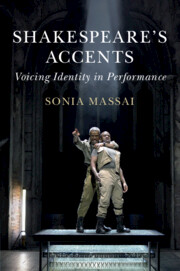Book contents
- Shakespeare’s Accents
- Shakespeare’s Accents
- Copyright page
- Dedication
- Contents
- Illustrations
- Acknowledgements
- Abbreviations and Conventions
- Introduction
- Chapter 1 ‘Accents Yet Unknown’: The Changing Soundscape of Shakespeare in Contemporary Performance
- Chapter 2 ‘Lend Me Your Ears’: Experiments with Original Pronunciation
- Chapter 3 David Garrick’s ‘Sonic Revolution’: Hegemony and Protest, 1737–1843
- Chapter 4 ‘Usual Speech’ and ‘Barbarous Dialects’ on the Early Modern Stage
- Conclusion
- Bibliography
- Index
Conclusion
Published online by Cambridge University Press: 07 May 2020
- Shakespeare’s Accents
- Shakespeare’s Accents
- Copyright page
- Dedication
- Contents
- Illustrations
- Acknowledgements
- Abbreviations and Conventions
- Introduction
- Chapter 1 ‘Accents Yet Unknown’: The Changing Soundscape of Shakespeare in Contemporary Performance
- Chapter 2 ‘Lend Me Your Ears’: Experiments with Original Pronunciation
- Chapter 3 David Garrick’s ‘Sonic Revolution’: Hegemony and Protest, 1737–1843
- Chapter 4 ‘Usual Speech’ and ‘Barbarous Dialects’ on the Early Modern Stage
- Conclusion
- Bibliography
- Index
Summary
The conclusion considers how the principles currently informing the allocation of public funding to theatre are having little impact on encouraging acoustic diversity on the Shakespearean stage, especially in Shakespearean production recently staged by large National Portfolio Organizations (NPOs), such as the Royal Shakespeare Company and the National Theatre. A statistically insignificant amount of public funding is currently invested in supporting smaller companies or independent projects, which seem better placed to diversity the soundscape of Shakespeare in performance.
Keywords
- Type
- Chapter
- Information
- Shakespeare's AccentsVoicing Identity in Performance, pp. 190 - 206Publisher: Cambridge University PressPrint publication year: 2020

